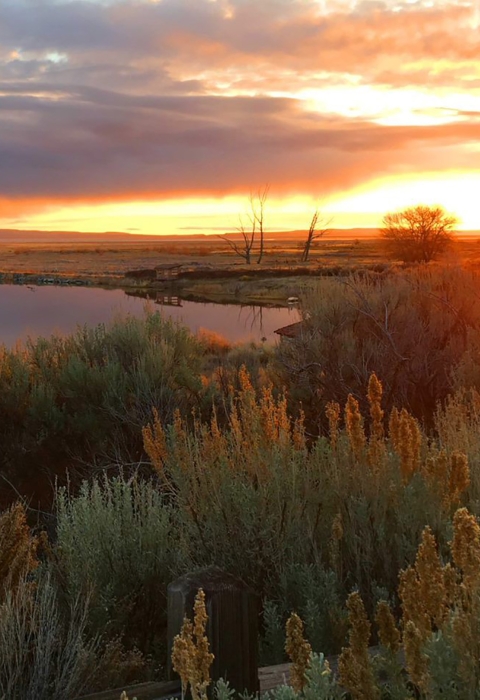The U.S. Fish and Wildlife Service (Service) in cooperation with the Bureau of Land Management (BLM) has issued a draft Environmental Assessment (EA) to withdrawal 199 acres of Malheur National Wildlife Refuge (Refuge) from appropriation under public land laws including location and entry under U.S. mining laws for up to 100 years or more. A withdrawal also allows the 199 acres to be managed as part of the Refuge.
The 199 acres addressed in the EA were originally withdrawn by the Secretary of the Interior in 1983 for a term of 40 years expiring in 2023. While these 199 acres have remained under FWS management as part of the NWRS, and the Secretary could have proposed extending PLO No. 6470 for an additional 40 years, and future Secretaries could have proposed extending PLO No. 6470 for yet another 40 years, the Secretary is proposing a new withdrawal of these acres for 100 years or more for administrative convenience, to ensure protection of these Refuge System acres from any adverse impacts associated with location and entry under the U.S. mining laws. Because land once withdrawn for addition to the Refuge System remains part of the System unless otherwise specified by Congress, this EA also evaluates the impacts of a Secretarial withdrawal of these acres for an indefinite term.
The Draft EA has been prepared in accordance with the National Environmental Policy Act and evaluates the effects of the proposed action on the natural and human environment. The purpose and need for the proposed action are to support continued management of the 199 acres of public lands as part of the Refuge as a preserve and breeding ground for native birds and to preclude any new location or entry under the U.S. mining laws on these lands that may interfere with this and other Refuge purposes.
The deadline for public comment is December 5, 2024; please submit comments by mail to Malheur National Wildlife Refuge, 36391 Sodhouse Lane Princeton, OR 97721, or by email to malheur@fws.gov.
You can find the Draft Environmental Assessment HERE
- Dallas Lore Sharp (1914) remarked on Lake Malheur Bird Reservation
Visit Us
Malheur National Wildlife Refuge is located in southeastern Oregon’s high desert, at the northern end of the Great Basin. It is adjacent to Steens Mountain, from which the Wild and Scenic Donner und Blitzen River flow into the Refuge’s southern boundary. The Refuge is famous for spectacular concentrations of wildlife, which are attracted to the Refuge’s habitats and abundant water resources in an otherwise arid landscape. Visitors are drawn to Malheur’s abundant wildlife and natural resources, and the variety of recreational opportunities the Refuge provides for visitors to enjoy.
Brochures
Location and Contact Information
About Us
For thousands of years, people have been drawn to Malheur's abundant wildlife and natural resources. The story begins with the earliest evidence of people to the establishment of the Refuge. Malheur is committed to protecting these resources of plants, animals, and human interactions with each other, and the landscape over time. Learn more about the geology and geomorphology of the area, Native American uses, the era of the fur trappers, settling the land and setting aside land for wildlife, the profound effect of the Civilian Conservation Corps (CCC) at Malheur, and the establishment of the Refuge.
What We Do
The National Wildlife Refuge System is a series of lands and waters owned and managed by the U.S. Fish and Wildlife Service. Wildlife conservation is at the heart of the Refuge System. It drives everything we do from the purpose a refuge is established, to the recreational activities offered there, to the resource management tools we use. Selecting the right tools helps us ensure the survival of local plants and animals and helps fulfill the purpose of Malheur National Wildlife Refuge.
Our Species
Malheur National Wildlife Refuge was established in 1908 to protect migratory waterfowl, with an emphasis on colonial nesting species. Today, the Refuge encompasses over 187,000 acres that are disproportionately important as a stop along the Pacific Flyway, and as a resting, breeding, and nesting area for hundreds of thousands of migratory birds and other wildlife. Many of the species migrating through or breeding at Malheur are highlighted as priority species in national bird conservation plans.
Get Involved
Whether you want to further conservation, learn more about nature, or share your love of the outdoors, you’ve come to the right place. National wildlife refuges provide many opportunities for you to help your community by doing what you love. National wildlife refuges partner with volunteers, youth groups, landowners, neighbors, and residents of urban and coastal communities to make a lasting difference. Find out how you can help make American lands healthier and communities stronger while doing something personally satisfying.


